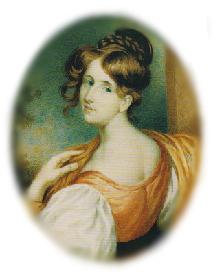
This delightful old Cheshire town is on the old London-Liverpool Toll Road (A50). Only two miles from junction 19 (Tabley) of the M6 Motorway it is thus easily accessible by road. Local bus services are operated by Cheshire Bus and there is a frequent railway service on the Manchester and Cheshire line. The International Airport at Manchester is only ten miles away. (Historic Knutsford)
This is a Knutsford page with a map and more than 70 old and new prints added to the text of "A Cranford Walk Around Knutsford" which has been revised by Hon. Sec. of "The Gaskell Society", Mrs. Joan Leach (a walking dictionary / cycling cyclopedia of Knutsford and Gaskell), Far Yew Tree House, Over Tabley, Knutsford, Cheshire, WA16, 0HN (Telephone) 01565 634668. All rights reserved. Any print related to old Knutsford may not be reproduced, in any form or by any means, without the prior permission of Mrs. Leach. As for prints of new Knutsford please feel free to download them. Joan Leach, Knutsford: A History (The History Press, 2013)
Last updated: 22 January 2017.
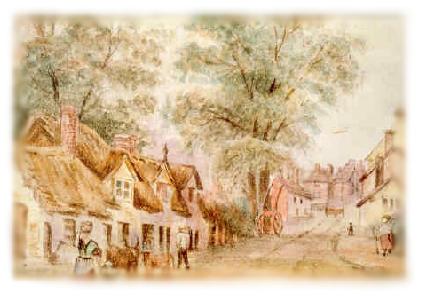
'Knutsford, before the Railway was made, in 1860.' 
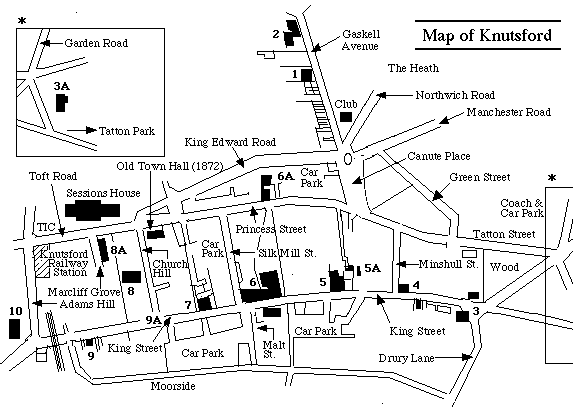
Elizabeth Cleghorn Stevenson was born in Chelsea in 1810, but after her mother's early death she was brought up by her aunt Mrs. Lumb in Knutsford. As Mrs. Gaskell, she portrayed her 'dear adopted, native town' in Cranford. Many of the scenes can still be identified so with this guide you can rediscover Cranford days. (Sorry no sedan chairs available.)
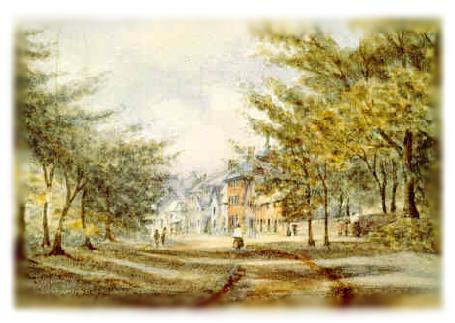 The Heath, where Betty Barker's cow fell into the lime pit was common land. It had a race course and grandstand in Mrs. Gaskell's day. Both sides in the Civil War (c. 1650) camped here, so did American soldiers in the last war. These cottages stood where the Conservative Club is now. Note the fire bell on one cottage.

King Street, Knutsford
(1) Mrs Lumb's House Past and Present Past and Present
Heathwaite, Gaskell Avenue where Elizabeth spent a happy childhood with Aunt Hannah Lumb 'more than mother' to her. Looking at this house and the Heath you may recall the opening lines of Cranford . . . 'for keeping the trim gardens full of flowers without a weed to speck them, for rushing out at the geese that accidentally venture in if the gates are left open, the ladies of Cranford are quite sufficient. . . .' From the bedroom windows, Elizabeth would see the grandstand for the annual races held on the Heath for two hundred years; no doubt these were an attraction to Highwayman Higgins who lived at Heath House (No. 2) from 1756 to 1764. Later Hon. Mrs. Grey lived here; she was related to Mrs. Jamieson! (in Cranford) She died in 1824. (2) Higgins' House Past and Present Past and Present
Edward Higgins was thought to be 'quite the gentleman' and even counted Samuel Egerton of Tatton among his friends but he lived on the proceeds of robbery until hanged at Carmarthen in 1767. ("Mrs. Gaskell wrote "The Squire's Story", based on his exploits. He passed as a gentleman and wed a Knutsford lady, but left this house hurriedly under suspicion. Tradition has it that he had an escape tunnel under the Heath. (3A) Lady Cumnor's School, now Golf Club-House Past and Present Past and Present
The Golf Club-house was originally a girls' school built by Mrs. Egerton in 1815, to teach them, as in Wives and Daughters, to be "capital housemaids" . . . with ready curtseys and "please ma'ams". . . . A writer on Cheshire c. 1817 (Itinerary of Cheshire by J. J. Hanshall) described the 'handsone gates" to Tatton Park which were "an ornament to the town. Near this is the spinning school founded and supported by the praiseworthy benevolence of Mrs Egerton of Tatton. Here 80 day scholars have the benefit of gratuitous instruction in reading, writing and arithmetic, six orphan girls are also instructed and maintained in a way calculated to make them good servants and situations are obtained for them by the humanity of the amiable patroness". This is clearly the origin of Lady Cumnor's charity school, and I am sure that Elizabeth's aunt, Mrs Lumb and her cousins Mary and Lucy Holland would be visitors. (3) Old Vicarage Past and Present Past and Present
'The little, straggling town faded away into country on one side close to the entrance lodge of a great park where lived my Lord and Lady Cumnor'. Compare Mrs. Gaskell's description from Wives and Daughters with the scene today. It is not so different, though no lords and ladies live there today: Tatton Park alias Cumnor Towers is now a National Trust property. The elegant house at the corner of Drury Lane and King Street was known as the Old Vicarage and is thought to be the scene Mrs. Gaskell had in mind when she told the story of Peter, the vicar's son dressing up in his sister's clothes and pretending to carry a baby. After his father beat him in front of the crowd who had gathered to watch his antics, he ran away to India. His return at the end of Cranford was a wish fulfillment for Mrs. Gaskell whose only brother disappeared while with the East India Company. (4) Marble Arch and Angel Inn Past and Present Past and Present
Past the ex-Post Office is Marble Arch, the Angel Inn until about 1710: note the mounting block. The Inn then moved across the road. In Cranford Lord Maulever stayed here while visiting Captain Brown, whose humble household could not entertain such an august personage. The Cranford ladies were disappointed not to meet him socially; the only person he spoke to was 'a little lad he had sworn at for driving a dirty hoop against the aristocratic legs'. (5A) Heritage Centre Past and Present Past and Present
The Heritage Centre in a reconstruction of a seventeenth century timber framed building which stood on this site, although it was found that some of the timbers may date from an earlier period. During the nineteenth century the building was a smithy. The building's use before this time is unclear, but it is possible that it may have been a stable. It was then used as shop store before it was left to become derelict. (© Knutsford Heritage Centre) Here there is an exhibition on the town's history and a shop selling gifts, Gaskell books, etc. 90a, King Street, Knutsford, Cheshire (Telephone) 01565 650 506 (5) Jackson's General Store Past and Present Past and Present
The black and white building, now a kitchenware shop and Chinese restaurant, was Jackson's general store in Mrs. Gaskell's day; it appeared in Cranford as Johnson's, where Miss Matty realised that she had become poor by a bank failure. (6) Royal George Past and Present Past and Present
The Royal George is depicted in several of Mrs. Gaskell's works. The Cranford ladies met 'at the door under the carriage way' to see the magician, Signor Brunoni perform. They went to the 'cloakroom where Miss Matty gave a sigh or two to her departed youth as she adjusted her pretty new lace cap before the strange, quaint old mirror'. In Wives and Daughters Roger Hamley came and went on his travels by the 'Umpire' and 'Bang up', names of actual stage coaches which called at the George. In the house opposite the Royal George, Mrs. Gaskell's cousin Sir Henry Holland was born in 1788. He was a famous society doctor, present at Prince Albert's death and friend and doctor to six prime ministers. He was also a great traveller. Mrs. Gaskell wrote in a letter 'Dr. Holland has been at Moscow since you saw him and is at Knutsford on his way to Algeria'; he was then 64. Besides being a noted coaching inn 'The Assembly Rooms' were in this building, they had been paid for by the subscriptions of the gentry and probably inspired awe in the young Elizabeth as they did in Edward Wilkins ("A Dark Night's Work" Chapter 1) he "had been at many splendid assemblies abroad but still the little old ballroom attached to the George Inn in his native town was to him a place grander and more awful than the most magnificent saloons he had seen in Paris or Rome". Earlier the author explains that "into those choice and mysterious precincts no townsperson was ever allowed to enter; no professional man might set his foot therein; no infantry officer saw the interior of that ball or that card room". (6A) Miss Matty's Teashop Past and Present Past and Present
Miss Matty's Teashop (for sale of tea--not what we think of as a teashop) probably existed only in Mrs. Gaskell's imagination. However, this building (ODD-BINS) was the home of Miss Harker who really did own a cow which lost its hair after falling into the lime pit on the Heath. She was the prototype for Miss Betty Barker in Cranford. The largest house in the picture was the home of Dr. Holland's daughter, married to his partner, Richard Deane who was doctor to the gaol. The Gaskells often visited here. (Demolished about 1932.) (Return to King Street or proceed to Toft Road for 8 and 8A.) (7) Gaskell Memorial Tower Past and Present Past and Present
Gaskell Memorial Tower built in 1907 by Richard Harding Watt in 'Mediterranean' style. Note list of Gaskell Works and improving texts! This building gives a focal point to King Street though its flamboyant style is not to everyone's taste. Besides being a memorial to Elizabeth Gaskell the building had a social purpose; it provided newspapers and a library, concerts and musical evenings in an attempt to wean the working man away from the pub. The original menu stated that "a warm bath may be had at any hour for sixpence". Galsworthy enjoyed a stay here and it later served as a setting for the TV version of The Forsyte Saga. At the dedication ceremony in 1907 Watt said that Mrs Gaskell's works had given him real delight, and he thought that they should acknowledge their famous townswoman. And as for the controversial building he had no wish to monopolise the honour of paying homage to Mrs Gaskell, but he found the best committee was that of one person! He contributed two drawings to the Knutsford edition of Cranford. (8) St. John's Parish Church Past and Present Past and Present
On 30th August 1832, Elizabeth married Rev. William Gaskell at St. John's Parish Church, Knutsford as non-conformist churches were not licensed for marriage at that time. She wrote later that most of the houses were 'sanded' for her wedding. This local custom consists of patterns made on the pavements using coloured sands and a funnel. It is still done for May Day and occasionally for weddings. Knutsford has an official sandman. (8A) Hollingford House Past and Present Past and Present
Hollingford House, Toft Road, was the setting for Doctor Gibson's house in Wives and Daughters where Hollingford was an alias for Knutsford. As Church House it was the home of Mrs. Gaskell's uncle Dr. Peter Holland and his daughters, usually accepted as models for the Misses Jenkins in Cranford. The Doctor, who attended the Egertons of Tatton and the apprentices at Styal Mill, joked that he never lost sight of his patients in the church yard. (9) Captain Brown's House Past and Present Past and Present
The large white house, number 15 (now a chocolate shop), was the home of Captain Hill, adjutant of the Cheshire Yeomanry. In Cranford he appears as Captain Brown who shocked the ladies by speaking of being poor, 'not in a whisper to an intimate friend . . . but in the public street, in a loud, military voice'. Lord Egerton gave him this house at a peppercorn rent and supplied a pig for fattening--note out buildings. (9A) King Street Past and Present Past and Present
 (10) Brook Street Chapel Past and Present Past and Present
Brook Street Unitarian Chapel, Knutsford was built about 1690 after the Act of Toleration was passed allowing dissenters to have their own chapels - before that date they were heavily fined for holding their own meetings and not attending the established church. It became Unitarian about 1780 though I note that the library books, several donated by Mrs Lumb or the Holland family, were labelled "Knutsford Presbyterian Chapel". In Ruth (Chapter 14) the chapel described is identical with this one: "the staircases which led to the galleries were outside, at each end of the building and the irregular roof and worn stone steps looked grey and stained by time and weather . . . the casement windows . . . were made of heavy leaded diamond shaped panes. . . . The interior was plain and simple . . . the walls were whitewashed. . . .' All that has changed is that the building is no longer covered with ivy. This was Mrs. Gaskell's spiritual home, known and loved all her life. Here she is buried, her ancestors' graves all around, with her husband and two of her daughters. Cranford first appeared in Dickens's Household Words between December 1851 and May 1853. In book form it was 'known and loved from Maine to California' and translated into many languages.
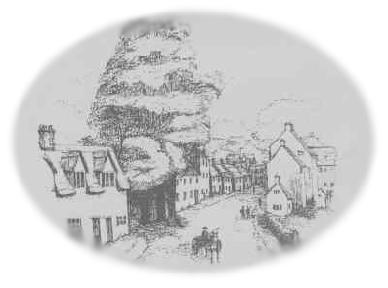
Lower Street, Old Knutsford, from near Tatton Park Gates
Knutsford Web Sites
E-mail for feedback: matsuoka@lang.nagoya-u.ac.jp |



 Top of Page
Top of Page Matsuoka's Home Page
Matsuoka's Home Page